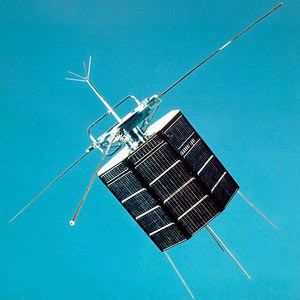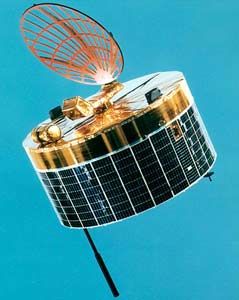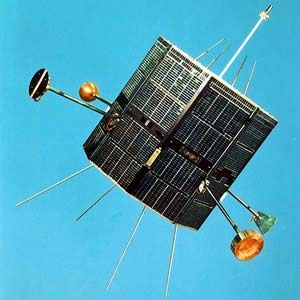SS (original) (raw)

Home - Search - Browse - Alphabetic Index: 0- 1- 2- 3- 4- 5- 6- 7- 8- 9
A- B- C- D- E- F- G- H- I- J- K- L- M- N- O- P- Q- R- S- T- U- V- W- X- Y- Z
SS

SS-02 Denpa
Credit: Manufacturer Image
Japanese earth magnetosphere satellite. Scientific observations in outer space. Research satellite operated by ISAS, Japan. Launched 1970 - 1971.
AKA: Corsa;MS;REXS;SRATS. Status: Operational 1970. First Launch: 1970-09-25. Last Launch: 1985-08-18. Number: 6 . Gross mass: 66 kg (145 lb).
NASA NSSDC Master Catalog Description
Suisei (the Japanese name meaning `Comet') was launched on August 18, 1985 into heliocentric orbit to fly by Comet P/Halley. It is identical to Sakigake apart from its payload: a CCD UV imaging system and a solar wind instrument. The main objective of the mission was to take UV images of the hydrogen corona for about 30 days before and after Comet Halley's descending crossing of the ecliptic plane. Solar wind parameters were measured for a much longer time period. The spacecraft is spin-stabilized at two different rates (5 and 0.2 rpm). Hydrazine thrusters are used for attitude and velocity control; star and sun sensors are for attitude control; and a mechanically despun off-set parabolic dish is used for long range communication. Suisei began UV observations in Nov. 1985, generating up to 6 images/day. The spacecraft encountered Comet P/Halley at 151,000 km on sunward side during March 8, 1986, suffering only 2 dust impacts. Fifteen burns of Suisei's 3 N motors over 5--10th of April 1987 yielded a 65 m/s velocity increase for a 60,000 km Earth gravity assist swingby on August 20, 1992, although the craft was then lost behind the Sun for the summer. The hydrazine was depleted on 22 February 1991. Preliminary tracking indicated a 900,000 km flyby had been achieved. ISAS had decided during 1987 to guide Suisei to a Nov. 24, 1998 encounter with P/Giacobini-Zinner, but due to depletion of the hydrazine, this, as well as plans to fly within several million kilometers of Comet P/Tempel-Tuttle on Feb. 28, 1998 has been cancelled.
More at: SS.
Subtopics
| SS-60 Brazilian tactical ballistic missile. |
|---|
| SS-300 Brazilian short range ballistic missile. |
|---|
| SS-1000 Brazilian intermediate range ballistic missile. |
|---|
| SS-25 Brazilian tactical ballistic missile. |
|---|
Family: Earth, Magnetosphere sat. People: Foerschner, Gross, E. Country: Japan. Launch Vehicles: Mu, Mu-4S, Mu-3C, Mu-3S-II, Mu-3. Launch Sites: V-2 Gruppe Nord, V-2 Gruppe Sued, Kagoshima, Kagoshima M. Agency: ISAS. Bibliography: 126, 2, 6, 11826, 13189, 13190, 13191, 13192.
Photo Gallery
 |
SS-11 SuiseiCredit: Manufacturer Image |
|---|
 |
SS-03 TaiyoCredit: Manufacturer Image |
|---|
1970 September 25 - . Launch Site: Kagoshima. Launch Complex: Kagoshima M. LV Family: Mu. Launch Vehicle: Mu-4S. FAILURE: Fourth stage failed to ignite.. Failed Stage: 4.
- SS - . Payload: MS-F1. Nation: Japan. Agency: ISAS. Class: Earth. Type: Magnetosphere satellite. Spacecraft: SS. Decay Date: 1970-09-25 . Apogee: 712 km (442 mi).
1971 September 28 - . 04:00 GMT - . Launch Site: Kagoshima. Launch Complex: Kagoshima M. LV Family: Mu. Launch Vehicle: Mu-4S.
- SS-01 Shinsei - . Payload: MS-F2. Mass: 65 kg (143 lb). Nation: Japan. Agency: ISAS. Class: Earth. Type: Magnetosphere satellite. Spacecraft: SS. USAF Sat Cat: 5485 . COSPAR: 1971-080A. Apogee: 1,866 km (1,159 mi). Perigee: 872 km (541 mi). Inclination: 32.00 deg. Period: 113.10 min. Scientific observations in outer space. Injection point 29 deg 7 min N, 145 deg 8 min E. .
1972 August 19 - . 02:40 GMT - . Launch Site: Kagoshima. Launch Complex: Kagoshima M. LV Family: Mu. Launch Vehicle: Mu-4S.
- SS-02 Denpa - . Payload: REXS. Mass: 75 kg (165 lb). Nation: Japan. Agency: ISAS. Class: Earth. Type: Magnetosphere satellite. Spacecraft: SS. Decay Date: 1980-05-19 . USAF Sat Cat: 6152 . COSPAR: 1972-064A. Apogee: 6,322 km (3,928 mi). Perigee: 238 km (147 mi). Inclination: 31.00 deg. Period: 157.40 min. Ionospheric experiments. Scientific observations in the ionosphere and magnetosphere. Interjection point 31 deg 15' N 11 deg 05' E. .
1975 February 24 - . 05:25 GMT - . Launch Site: Kagoshima. Launch Complex: Kagoshima M. LV Family: Mu. Launch Vehicle: Mu-3C.
- SS-03 Taiyo - . Payload: SRATS. Mass: 86 kg (189 lb). Nation: Japan. Agency: ISAS. Class: Earth. Type: Magnetosphere satellite. Spacecraft: SS. Decay Date: 1980-06-29 . USAF Sat Cat: 7671 . COSPAR: 1975-014A. Apogee: 3,125 km (1,941 mi). Perigee: 254 km (157 mi). Inclination: 31.50 deg. Period: 120.20 min.
Examined solar radiation, thermospheric structure. SRATS (Solar and Thermospheric Radiation Satellite) is the third Japanese scientific satellite, to study the intereffects of solar radiation and the thermosphere of the earth. National name: Taiyo. Launch time 0525 GMT.
1979 February 21 - . 05:00 GMT - . Launch Site: Kagoshima. Launch Complex: Kagoshima M. LV Family: Mu. Launch Vehicle: Mu-3C.
- SS-04 Hakucho - . Payload: Corsa B. Mass: 100 kg (220 lb). Nation: Japan. Agency: ISAS. Class: Earth. Type: Magnetosphere satellite. Spacecraft: SS. Decay Date: 1985-04-15 . USAF Sat Cat: 11272 . COSPAR: 1979-014A. Apogee: 566 km (351 mi). Perigee: 543 km (337 mi). Inclination: 29.80 deg. Period: 95.70 min.
Soft X-ray telescope. Launching organization: Institute of Space and Aeronautical Science, University of Tokyo. Function: Observation of X-ray radiation of celestial bodies with good time resolution over a wide spectrum range. Characterstics: weight 96 kg, configuration regula r octagonal prism, height 0.66 m, diameter 0.76m, spin stabilized. Expected life 2 years.
1985 August 18 - . 23:33 GMT - . Launch Site: Kagoshima. Launch Complex: Kagoshima M. Launch Pad: M1. LV Family: Mu. Launch Vehicle: Mu-3S-II.
- SS-11 Suisei - . Payload: Planet A. Mass: 141 kg (310 lb). Nation: Japan. Agency: ISAS. Class: Earth. Type: Magnetosphere satellite. Spacecraft: SS. USAF Sat Cat: 15967 . COSPAR: 1985-073A.
Rendezvoused with comet Halley 3/8/86. Solar Orbit (Heliocentric). PLANET-A (SUISEI). Launch time 2333 GMT. Imaging of the hydrogen coma of Halley's comet by the hydrogen Lyman alpha line. Measurement of the solar wind in the cruising phase and in the vicinity of the comet. Launching organiza tion ISAS. Heliocentric orbit parameters 282 days, inclination 0.888 deg, 151.42 x 100.5 million km (1.0122 x 0.6718 AU).
Home - Search - Browse - Alphabetic Index: 0- 1- 2- 3- 4- 5- 6- 7- 8- 9
A- B- C- D- E- F- G- H- I- J- K- L- M- N- O- P- Q- R- S- T- U- V- W- X- Y- Z
© 1997-2019 Mark Wade - Contact
© / Conditions for Use